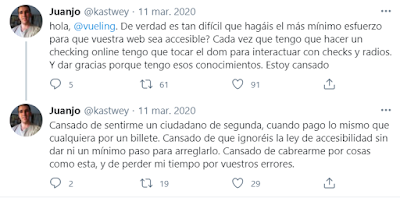Recientemente, WebAIM ha publicado Survey of Web Accessibility Practitioners #3 Results.
Los resultados más interesantes son:
- Web accessibility practitioners report being notably older than respondents to other web design/development surveys (as reported in the 2020 Stack Overflow survey).
- 57% of respondents were male, 40% of respondents were female (5 times higher than the broader design/development field), and 3% non-binary, genderqueer, or gender non-conforming (twice as high as the broader design/development field).
- 29% of respondents indicated having a disability (15 times higher than the broader design/development field).
- The average reported salary was at least $73,000, notably higher than the broader design/development field. Salaries of web accessibility practitioners have increased steadily over time.
- Female respondents earn an average of at least $6,100 less than their male counterparts, a notably increased gap from $2,100 reported in 2018.
- Respondents with disabilities reported an average of at least $1,800 less than respondents without disabilities, a notably decreased gap from $4,200 in 2018.
- Mac OS is now the most common operating system. Chrome dominates with 63% of respondents reporting it as their primary browser.
- Respondents are generally pessimistic about web accessibility progress over time with 87% indicating that accessibility has gotten worse or not improved over the last year.
- 21% of respondents from corporations/industry reported receiving a lawsuit, threat of lawsuit, or OCR complaint compared to 39% of respondents (nearly double) from educational institutions.
- NVDA (37%) and VoiceOver (35%) are the most commonly used screen readers for testing, compared to only 16% for JAWS (down from 37% in 2014).
- Axe, browser developer tools, and WAVE are reported as the most commonly used testing tools.
- 76% of respondents indicate that ARIA has made the web more accessible, though that sentiment is much lower among respondents with disabilities and with more accessibility experience.
- A strong majority (67%) of respondents rate web accessibility overlays, plugins, or widgets as not at all or not very effective. Respondents with disabilities were even less favorable with 72% rating them not at all or not very effective, and only 2.4% rating them as very effective.


